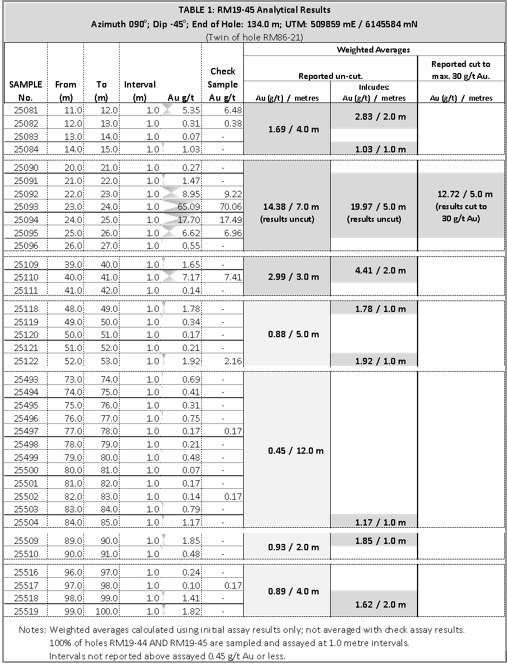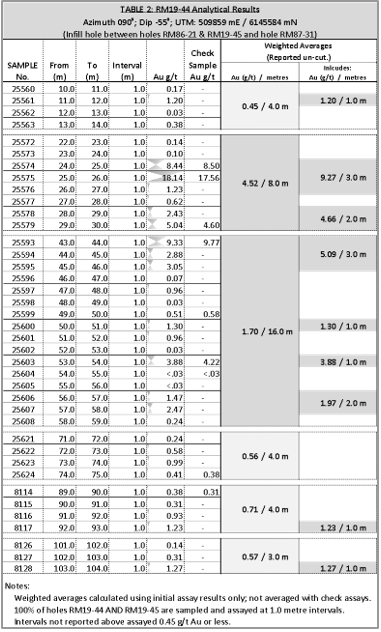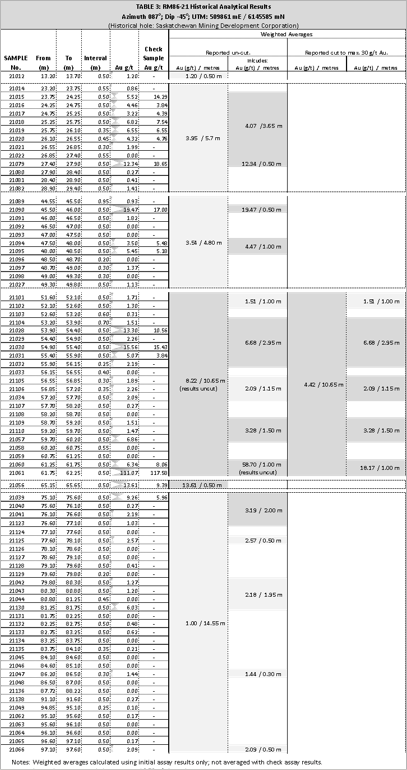Confirmation and Infill Drill Holes Completed at Point Gold Prospect Release of Results for Core Holes RM19-44 and RM19-45
VANCOUVER, BC / ACCESSWIRE / February 21, 2019 / MAS Gold Corp. ("MAS Gold'' - TSX.V: MAS). Ron Netolitzky, President and CEO, is pleased to announce assay results from this winter's first two core drill holes (RM19-44 and RM19-45) recently completed at the Point gold prospect on the Preview Lake property located about 60 kilometers northeast of La Ronge, Saskatchewan.
As outlined in MAS Gold's December 21, 2018 and January 30, 2019 news releases, the current drill program is designed to provide confirmation of historical drill results, infill and stepout drill intercepts and core for metallurgical testing.
''We are very excited to present these new drill results, highlighting both the potential of thelong-overlooked, but significant Point gold prospect, and the prospectivity of the La RongeGold Belt generally,'' remarked David Tupper, MAS Gold's Vice President of Exploration.
''Our initial assay results from holes RM19-44 and -45 are the first step in establishingconfidence in the results of the historical drilling at Point and are an important step inestablishing a potential NI 43-101 qualified resource here.''
At the Point gold prospect, historical assessment files report fine to coarse visible gold from numerous surface showings and drill holes, including RM86-21. MAS Gold has now successfully twined historic hole RM86-21, drilled by Saskatchewan Mining and Development Corporation (''SMDC'') in 1986 at azimuth 087o and dip -45o on Section 6145585N. RM86-21 intercepted multiple zones of gold-mineralized, sheared quartz veins within a carbonatealtered, tuffaceous volcanic host rock.
Confirmation hole RM19-45 was collared within a metre of RM86-21 and drilled at a dip of -45o on azimuth 090o to a total depth of 134 metres. Assay results from hole RM19-45 include a weighted average of:
- 14.38 grams gold per tonne (g/t) over a core length intercept of 7.0 metres beginning at a down hole depth 20.0 metres.
This 7 metre intercept includes a one metre sample interval of 65.09 g/t gold (sample 25093). A narrower 5.0 metre intercept from 21.0 to 26.0 metres, with the multi-ounce sample cut to 30 g/t gold, returned a weighted average of 12.72 g/t gold. Multiple intercepts of greater than 1 g/t gold and fine, visible gold occur in discrete sections along the first 100 metres of the hole, as shown in Table 1 below.
Infill hole RM19-44 was also drilled on Section 6145585 N with historic holes RM86-21, RM87- 31, -32, -33 & -35 and new hole RM19-45. Hole RM19-44, collared from within a metre of RM19-45 on azimuth 090o at a dip of -55o and drilled to a total depth of 154 metres, was designed to bisect between historic holes RM86-21 and RM87-31. Assays from hole RM19-44 include weighted averages of:
- 9.27 g/t gold over an intercept of 3.0 metres beginning at a down hole depth 24.0 metres; and,
- 4.66 g/t gold over an intercept of 2.0 metres beginning at a down hole depth 28.0 metres; and,
- 5.09 g/t gold over an intercept of 3.0 metres beginning at a down hole depth 43.0 metres, and,
- 3.88 g/t gold over an intercept of 1.0 metre beginning at a down hole depth 53.0 metres
Similar to holes RM86-21, -31 and RM19-45, multiple intercepts of greater than 1 g/t gold and fine visible gold were intersected in discrete sections throughout the top 100 metres of the hole RM19-44, as shown in Table 2 below.
Historical results for holes RM86-21 and RM87-31 are provided in Tables 3 & Table 4, respectively for comparison. Results are posted with both un-cut weighted averages and with weighted averages of results cut at a maximum of 30.0 g/t gold.
At the Preview Lake property, gold mineralization is associated with a variety of geological units, including calc-silicate altered sedimentary and mafic volcanic lithologies hosting clear grey quartz veins along a poorly defined, northerly trending zone of shearing. These host rocks variously exhibit silica and potassic alteration with trace, fine to coarse pyrite, sphalerite and tourmaline. Gold is the sole element of economic potential, often occurring as visible, fine 0.5 millimetre grains.
MAS Gold is waiting for analytical results from an additional two infill holes (RM19-46 and -47) designed to further confirm the historic results obtained by SMDC. Holes RM19-48 through RM19-56, located to test the down dip and north extensions of the mineralization are also complete and awaiting processing and analysis. To date thirteen holes have been drilled at Point for a total of 1,947.0 metres.
North Lake Update
Drilling on the North Lake property, located about 5 kilometres north-northwest of the Point Prospect is expected to commence before the end of February. Development of access trails 3 and a core handling facility are currently underway. Ten core holes totalling 1,505 metres are planned for the North Lake property.
Data Verification, Sampling Procedures & QA/QC
The current drilling was conducted to verify the presence of gold in historical drill holes RM86- 21 and RM87-31. Holes RM19-44 and RM19-45 were collared within one metre of the collar location of RM86-21. The collar of hole RM86-21 (casing left in) was located in the field and collar azimuth and dip orientation were confirmed. Down hole orientation surveys are being undertaken on the currently reported drill program, however downhole survey data, where available, is less reliable for all historical drilling. Hole RM19-45 (Azm. 090o ; dip -45o ) models well as a twin of RM86-21 (Azm. 087o ; dip -45o ), although with less reliable downhole survey data available for RM86-21 there is uncertainty regarding its relative end of hole position. The 3 degree difference in azimuth direction at the collar alone could result in up to 17.8 metre separation in plan at 125 metres drill depth. Holes RM19-44 (Azm. 090o ; dip -55o ) models well as an infill hole, twining RM86-31 (Azm. 087o ; dip -45o ) at 120 metres depth where a separation of less than 8 metres on section is modelled. Holes RM19-46 and RM19-47 (pending) were designed to provide similar infill data. Drill intersections are reported as drill thicknesses; true widths of mineralization vary between 70% and 100% of drilled thicknesses reported due to variations in drill orientations.
All core is managed in a secure facility on the property, where it is logged (geological, geotechnical), tagged, photographed and sawn. To date the entire length of each hole is being sampled at consistent 1.0 metre lengths. Half of all core is retained for permanent record. Selected samples are recorded, checked and sealed in individual plastic bags, then put in rice bags for shipment by courier from La Ronge. All core is oriented using a Reflex ACTIII orientation tool on the drill.
All core samples are sent to TSL Laboratories in Saskatoon for analysis. Core samples are crushed to a minimum 70% passing 10 mesh. A roughly 250 gram representative split sample is obtained from the entire reject sample using a riffler. The split sample is pulverized to a minimum 95% passing through a 150 mesh sieve. Due to the presence of coarse gold, the pulverizer is cleaned using a sand wash after every sample. Gold is analyzed by Fire Assay/Gravimetric methods using a 1 Assay Ton charge. Gold detection limit for the FA/Gravimetric method is 0.03 g/t. Reject pulps are saved and stored for potential, future metallic screen analyses.
TSL in-house standards are inserted approximately every 20 samples, as well as three pulp duplicates for FA/Gravimetric work. Standards are from a number of sources such as CDN Labs, OREAS or Rocklabs. MAS Gold's quality assurance and quality control procedures include the systematic insertion of standards into the sample string. QA/QC results were within expectations.
The 1986 historical drill core samples were processed by TSL Laboratories in Saskatoon. Gold assays were performed one assay ton subsamples of -100 mesh material using a fire assay preconcentration with a gravimetric finish. The 1987 historic drill core samples were processed by Ecotech Labs in Kamloops BC. Gold analyses were performed on one half assay ton 4 subsamples of -100 mesh using aqua regia digestion with and AA finish. Metallic screen assays were performed on samples that assayed greater than 1000 ppb gold and on all samples containing visible gold. No historical standards or check sample procedures are reported by either SMDC or the labs involved. Copies of original historical assay certificates were reviewed and results tabulated digitally.
Qualified Person
David Tupper, P. Geo. is a qualified person (''QP'') within the context of National Instrument 43- 101, and has prepared, read and approved the technical aspects of this news release.
About MAS Gold Corp.
MAS Gold Corp. (formerly Masuparia Gold Corporation) is a Canadian mineral exploration company focused on exploration projects in the prospective La Ronge Greenstone Belt of Saskatchewan. MAS Gold's projects include the advanced-stage Greywacke deposit, which hosts high-grade gold-bearing zones with a National Instrument 43-101 compliant (at a cut-off grade of 5 grams gold/tonne) Indicated Mineral Resource of 255,500 tonnes at 9.92 g/t Au plus an Inferred Mineral Resource of 59,130 tonnes at 7.42 g/t Au. MAS Gold's NI 43-101 Technical Report of June 1, 2016 concerning the Greywacke deposit is available on SEDAR and on MAS Gold's website: http://www.masgoldcorp.com.
On Behalf of the Board of Directors of MAS Gold Corp.
Ronald K. Netolitzky, President & CEO
Caution Regarding Forward-Looking Information and Statements:
This news release includes certain forward-looking statements or information that could cause actual results to differ materially from MAS Gold's plans or expectations. These include risks relating to the actual results of current exploration activities, fluctuating gold prices, possibility of equipment breakdowns and delays, cost overruns, availability of capital and financing and general economic, market or business conditions. All statements other than statements of historical fact included in this release, including, without limitation, statements regarding any updated technical report, are forward-looking statements that involve various risks and uncertainties. There can be no assurance that such statements will prove to be accurate and actual results and future events could differ materially from those anticipated in such statements.
Neither TSX Venture Exchange nor its Regulation Services Provider (as that term is defined in the policies of the TSX Venture Exchange) accepts responsibility for the adequacy or accuracy of this release.
MAS Gold Corp.,
Suite 420 - 789
West Pender Street
Vancouver, V6C 1H2, British Columbia
T: 604-685-8592
w: www.masgoldcorp.com
For more information, please contact:
Lubica Keighery
VP Corporate Development Canada
c: 778-889-5476
e. lubica@masgoldcorp.com
TABLE 1
TABLE 2
TABLE 3
SOURCE: MAS Gold Corp


